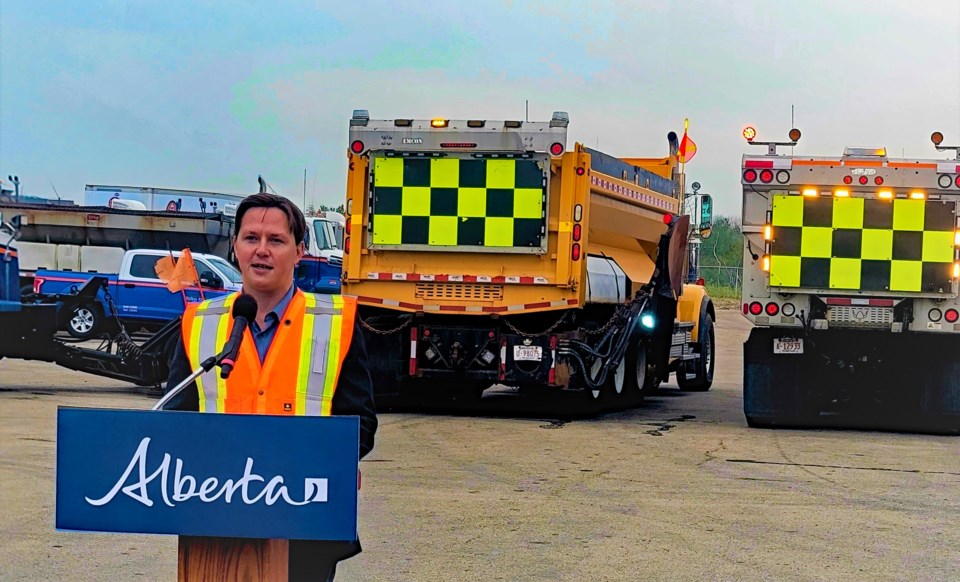While a veteran tow truck operator and a leading protective services manager in the region rage against the UCP’s new traffic safety rules, Minister of Transportation and Economic Corridors Devin Dreeshen says he won’t budge on the dialed back new controversial road legislation.
“We spent months leading up to September 1; to make sure that Albertans would know these new changes. We've had a significant ad campaign in the weeks and months leading up to this,” said Dreeshen, the UCP MLA for Innisfail-Sylvan Lake.
He said through his staff’s study of traffic collision reports from Canada, U.S. and other parts of the world it was determined that 30 per cent of all traffic collisions are due to speed fluctuation.
“Only one lane, that's three plus metres beside a roadside worker, that has to have a speed reduction to 60 kilometres an hour, or if the speed limit is lower,” said Dreeshen. “We didn't want to have 60 feet, or having five lanes of traffic, all slowed down to make a traffic wall - its own traffic jam - to be able to have all lanes slowed down to 60 because that would have a lot more collisions, a lot more accidents on Alberta roads.
“And it wouldn't be safe for motorists or for roadside workers themselves,” he added. “That's why we wanted to make this common sense change of all roadside workers are going to be treated equal.
“And they'll be 60 kilometres an hour beside the lane that they're working at, and then able to maintain consistent speed in lanes two, three, four, and five away from the roadside worker.”
The so-called "move over" legislation, which took effect Sept. 1, requires drivers in the lane closest to any stopped roadside worker's vehicle that has lights flashing to slow down to 60 kilometres per hour (km/h) or a lower speed if one is posted.
Drivers will also have to move to the next lane over and take reasonable steps to allow other drivers to do so.
The original legislation would have required drivers in all lanes of traffic travelling on the same side of the road as a stopped emergency or roadside worker vehicle to slow down to 60 km/h or the speed limit, whatever is lower, when emergency vehicle lights are flashing.
That rule would also have applied to vehicles travelling in both directions on highways that only have one lane in each direction.
“I do personally feel that the recent changes are not adequate for the protection of emergency workers on Alberta highways,” said Justin Andrew, Olds Fire Department chief and director of protective services for the Town of Olds. “When we as first responders operate on highways such as the QEII, in my opinion, it is the most dangerous thing that we currently do as firefighters.
“There is not a single time that we operate out there where someone - and in some cases multiple people - drive by at excessive speed and (do) not move over,” added Andrew. “The only time when we see significant reduction in speeds is when there is police presence and I feel it is because of the colour of the flashing lights and the potential for someone to get a ticket.”
Andrew said he’s aware that the Alberta Fire Chiefs Association has a “unified stance” on the new legislation and is lobbying the provincial government to make changes to it.
In the meantime, a veteran tow truck operator and business owner in Carstairs said changes must be made without delay to better protect emergency vehicle operators on Highway 2 and other roadways.
“It’s crazy to think that we can’t slow down everybody to 60 kilometres an hour for the safety of one human being in Alberta,” said Kirk Lewis, owner of Carstairs Towing, Highway 2 Towing, and Heavy Rescue Towing. “What I say to people out there is that if you get the phone call and it’s your child or loved one who gets maimed or killed, you have a different perspective on it.
“It should absolutely be both lanes. When people are approaching emergency services of any kind on the highway, it should be 60 kilometres an hour in all lanes, three lanes, two lanes, one lane, it doesn’t matter. It’s not a complicated issue; it just needs to be done.”
Lewis said towing association representatives, as well as representatives from police, EMS, ambulance, sheriffs, fire departments and other stakeholders, must be consulted regarding the situation.
“I’m really glad that the government is stepping up, but I think they need to have more input from these associations,” he said. “Obviously these are bureaucrats who are not working on the side of the road who make these decisions and that’s sad.
“If you want positive results, you need to approach it from all angles. The government needs to step up and involve some of the people who really understand this.”
For his part, Lewis say he has first-hand experience with the dangers of vehicles speeding past emergency scenes.
“I’ve been clipped,” he said. “I’ve been clipped by mirrors. I’ve been clipped by big trucks. People travel at excessive speed, at crazy speeds. They are coming by you at 110, 120, 130 kilometres an hour in the slow lane with all our lights going right now. It happens every call. It’s a kill zone.”



